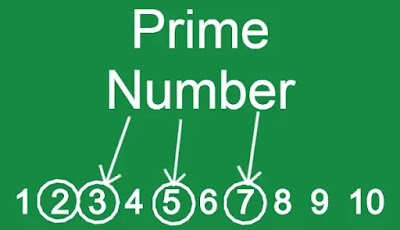Prime Number (Definition)
Natural numbers greater than 1, which themselves and are not divisible by any natural number other than 1, are called prime numbers.
Numbers that have no factors are prime numbers.
Natural numbers greater than 1 which are not whole numbers are called composite numbers. The number of prime numbers is infinite, which was demonstrated by Euclid 300 BC. 1 is not considered prime by definition. Because 1 is neither a composite nor a prime, some prime numbers list are given below.
2, 3, 5, 7, 11, 13, 17, 19,23, 29, 31, 37, 41, 43, 47, 53, 59, 61, 67, 71, 73, 79, 83, 89, 97

Some basic rules about prime numbers
- 2 is the smallest prime number.
- 2 is the only even prime number, the remaining prime numbers are odd.
- There are a total of 25 prime numbers from 1 to 100.
The importance of prime numbers is that the factors of any nonzero natural number can be expressed only by prime numbers and this factor is unique. This is called the fundamental theorem of arithmetic.
The prime number is also called the conservative number.
Quality of conventional numbers
Every natural number greater than 1 must have at least one conventional divisor.
Rules for checking prime numbers
Suppose we have to find out whether 397 is a prime number or not, then we will use the following step.
- Find the smallest number which is a perfect square and is larger than 397, so that number will be 400 which is a square of 20.
- Now choose prime numbers smaller than 20 which is 2,3,5,7,11,13,17.
- Now divide 397 from each of the above prime numbers, ie, 2,3,5,7,11,13, and divide 17 by rotation. 397 is not completely divisible by any of them, so 397 is a prime number.
History
The knowledge of prime numbers in ancient Egypt is indicated in Rhind Papyrus. Detailed information on the prime number is found in the book "Elements" written by the mathematician Euclid of Ancient Greece (300 BC). The next detailed mention of prime numbers is found by the mathematician Pierre de Fermat (1601-1665) of the seventeenth century. The format gave a formula from which prime numbers can be estimated. Format speculated that any number that could be written as (2 ^ 2 ^ n +1), where n is a natural number, would be prime numbers. Although this was true up to n = 4, the number at n = 5 - (2 ^ 32 +1) is divided by 641, so it is not a prime number. The remarkable work that followed on the prime number goes to the German scientist and mathematician Johann Karl Friedrich Gauss (1777-1855).
In mathematics, there are many number series, such as geometric series, parallel series, etc., whose formula can be used to find a number in a series, but no such series of prime numbers is found because it is Does not follow the permanent format. This is still an unresolved problem in the field of mathematics.
